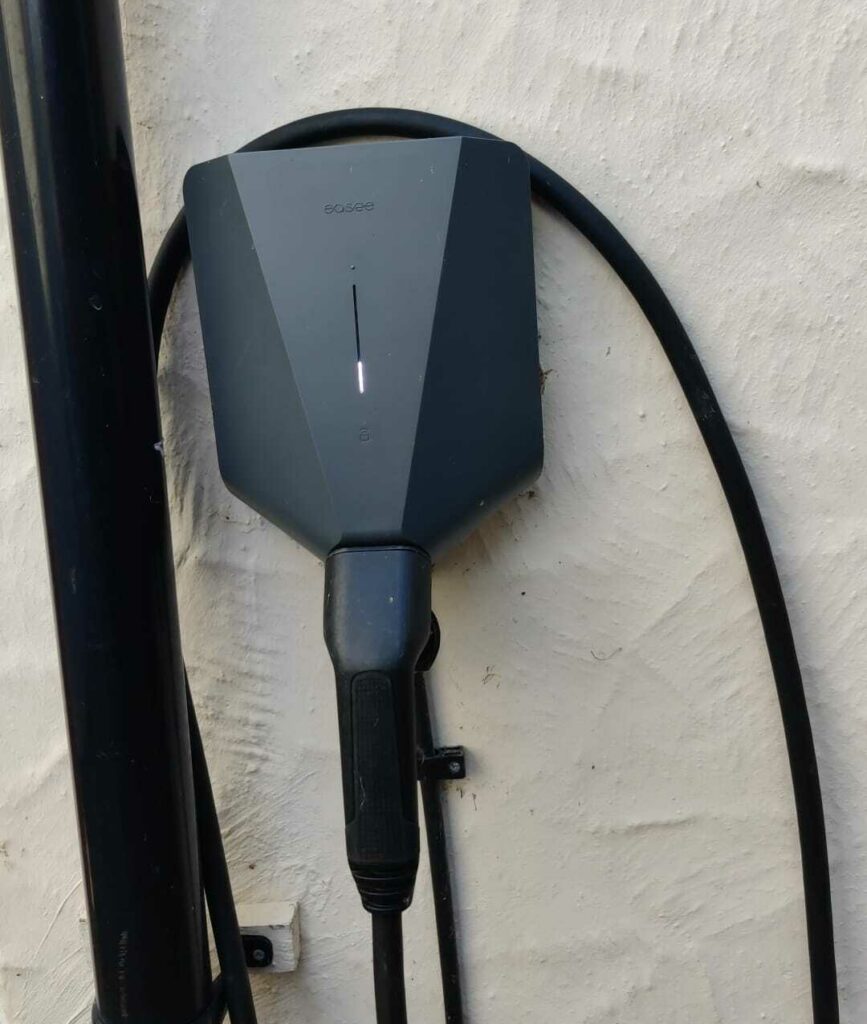
Although the transition to 100% of new cars being zero emission was moved back to 2035 recently, it is still expected that 80% of new cars will be electric vehicles (EVs) by 2030. For those with off-road parking, charging at home can be economical (See the bottom of the post for other possibilities for on-road parking). We spoke to electrician Andrew Figge for advice on installing a home EV charger.
Andrew says: There are several points to consider:
- Where you park your vehicle will determine where to locate your charge point. Will your preferred location be a trip hazard (perhaps to visitors) when the charging cable is connected to the vehicle? Do you want the charge point to be visually discreet? Is there reliable WiFi (or mobile internet) signal at that location?
- Charge points come as tethered (integral charging cable) or untethered (no cable). Some people prefer the neater uncluttered look of the untethered unit, but this requires a separate cable to be carried and connected between vehicle and charge point. The tethered version offers a quicker and simplified connection.
- The charge point will require a dedicated circuit from the main consumer unit. Routing the new circuit will need some consideration as there may be disruption to the fabric and décor of the building or need a trench.
- Similarly the existing household consumer unit may require modification or even replacement to accommodate the new EV circuit requirements. Most often an additional dedicated EV consumer unit is installed alongside the existing consumer unit – is there space to install this? Is the main cutout fuse adequate or does it need upgrading?
- If you have or plan to have Solar PV, check whether your preferred charge point model can be integrated with solar to charge the vehicle with surplus electricity generated rather than exporting to the grid.
Andrew adds “Probably my favourite charger is the Myenergi Zappi – I’ve installed quite a few of these including two in the village. It has good integration with Solar PV and seems to have good reliability. Also good is the Podpoint Solo and I have installed one Easee unit. All these appear in the top 4 according to the What Car 2023 survey.”
One additional consideration is that there are some restrictions for installing chargers for all types of buildings, whether listed or not. You can find details of these at the planning portal by searching for “planning portal permitted development electric vehicle”. Listed buildings will require Listed Building Consent and planning permission.
Nikhil Saraswat, a Littlebury resident, has an Easee One charger. He says “I chose an untethered charger due to my location needing a cable that was at least 5 metres long. At the time, tethered chargers of that length were too expensive. All things considered the charger does the job and doesn’t look ugly or obtrusive. Unfortunately this charger isn’t easily solar compatible which is just about the only thing I don’t like about it.”

Another villager, Nick Dukes, who had a Myenergi Zappi charger installed says “We are very pleased with it. There are plenty of options to control and optimise charging – when to charge, Green mode etc. The interface on the unit is easy to understand. The only bad point would be that whilst it does interface with our solar panels, the app isn’t great – and the info doesn’t tally with the solar app (although of course that could be an issue with the Solar app!)”
A second villager who has an Easee One charger explained “I chose the Easee One Charger for the following reasons:
- it received good “expert” reviews at the time;
- it offered tethered / untethered capability (i.e. you can lock the cable to the unit or remove for security purposes or for use when travelling);
- simple, discreet, Scandi design;
- the unit includes a protective earthed neutral (PEN) conductor so there is need for a separate earth rod;
- data communication is via (free) integrated SIM or WiFi (i.e. useful if weak internet connection where unit is sited);
- it has integrated RFID security keys so only authorised users can activate charging.
My experience has been generally good and the charger appears robust and of solid construction. The initial operating instructions were only accessible via app which, although excellent for day-to-day operation, was poor. This was particularly irritating when, after installation, the system didn’t work and I subsequently discovered that, because I’d used an independent installer, it was necessary for Easee to complete the commissioning of the system (N.B. use of a local electrician wasn’t otherwise an issue and didn’t impair the warranty). There was limited customer service in the UK at the time. I experienced an issue whereby the cable unlocked even though the app showed a different status. When I eventually managed to contact an Easee representative they diagnosed the issue quickly and couriered a complete replacement unit to me whilst issuing separate instructions to guide Andy Figge to replace the relevant component.”
For those currently without a home charge point or without suitable parking, there are several other options. There is the network of commercial chargers of various speeds. Locally this includes chargers at the UDC offices, at Tescos, at Knights Retail Park, and recently reinstated at the Lord Butler Leisure centre. There are also networks that facilitate use of private chargers such as JustCharge or CoCharger. There are several apps that help locate chargers of which ZapMap is widely used. The Littlebury Parish Council has been looking for options for dedicated charger in the village but as yet there is nothing finalised.
There are government grants available for various installation scenarios for EV chargers including on-road parking, landlord, renters and flats.
